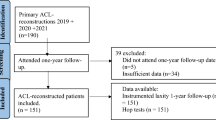Abstract
The purpose of this project was to determine if guidelines established by the International Knee Documentation Committee (IKDC) could distinguish differences in outcome, as indicated by the patients’ subjective rating of knee function following ACL reconstruction, and to determine if all subgroups included in the IKDC rating system contribute to the prediction of the overall final IKDC rating. A total of 133 patients undergoing ACL reconstruction were evaluated according to IKDC guidelines 1–5 years postoperatively. Each subject was rated in each of four subgroups on the IKDC scale: patient subjective assessment, symptoms, range of motion (ROM), and laxity. The worst rating for the subgroups defined the overall final rating. The outcome from the patient’s perspective was determined by asking them to rate the function of their knee on a scale from 0 to 100 with 100 being the level of function before injury. Average length of follow-up was 3.2 years (range 1.1– 6.3 years). ANOVA indicated that the patients’ subjective rating of knee function on a scale from 0 to 100 differed according to the overall final IKDC rating (F = 16.1, P < 0.001). The average subjective rating of knee function for those with a normal IKDC rating was 95.2, nearly normal was 91.2, abnormal was 84.9, and severely abnormal was 75.4. The average subjective rating of knee function for those who were severely abnormal was significantly different from those rated normal, nearly normal, and abnormal, and the average subjective rating for those who were abnormal was significantly different from those who were normal or nearly normal. There was no significant difference in average subjective rating between those who were rated as normal or nearly normal. Regression analysis indicated that all four subgroups contributed significantly to the prediction of the final IKDC rating (r 2 = 0.70), but the majority of the variance (62%) was accounted for by symptoms and laxity. These results appear to indicate that the IKDC guidelines are useful for describing the outcome following ACL reconstruction. Further testing of the IKDC guidelines is necessary to determine if they are capable of detecting a change in the patients over time following treatment and/or surgery of the knee.
Similar content being viewed by others
Author information
Authors and Affiliations
Additional information
Received: 5 June 1997 Accepted: 3 October 1997
Rights and permissions
About this article
Cite this article
Irrgang, J., Ho, H., Harner, C. et al. Use of the International Knee Documentation Committee guidelines to assess outcome following anterior cruciate ligament reconstruction. Knee Surgery 6, 107–114 (1998). https://doi.org/10.1007/s001670050082
Issue Date:
DOI: https://doi.org/10.1007/s001670050082




